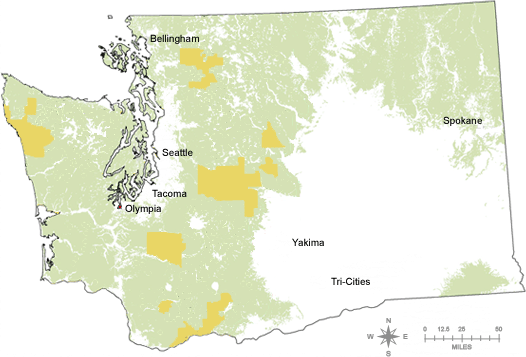
How are the Northern Spotted Owls Protected?
Spotted Owl Special Emphasis Areas
From 1992-1996, the State Forest Practices Board entered into a stakeholder process with tribes, environmentalists, and landowners to develop a cooperative strategy for non-federal forestland to protect the spotted owl. In order to complement the federal recovery and conservation strategy, the Board identified more than 2 million acres of forest called Spotted Owl Special Emphasis Areas (SOSEAs). Most of this land, about 1.2 million acres overlaps with state, private, and federal lands already managed under habitat conservation or federal management plans. Of the remaining 825,000 acres, the Board identified the primary function of these forests as either dispersal, nesting or roosting habitat for the owl. The State finalized its owl rule in 1996, which identified ten SOSEAs to complement the protection provided by the Northwest Forest Plan. State and private landowners who do not have their own Habitat Conservation Plan must protect a circle of habitat around an owl nest site. Within SOSEAs on the Olympic Peninsula, 14,567 acres of owl management circles are identified, in which 40% of the habitat is protected, or nearly 6,000 acres. All other SOSEAs have 6,514 acres of owl management circles, in which 40% of the habitat is protected, or about 2,600 acres.
State regulations also encourage development of voluntary landscape management plans within SOSEAs. Outside the SOSEAs, Washington State regulations protect 70 acres around each owl nest site. In addition to state regulations, the federal Endangered Species Act protects every individual owl from harm or injury, wherever it lives.
Forests & Fish Riparian Reserves
In 1996, Washington’s private forest landowners and five other stakeholder groups entered into negotiations to develop forestry regulations to address Endangered Species and Clean Water Act listings of salmon and streams. This resulted in sweeping changes to management practices to protect 60,000 miles of streams in Washington’s forests. The law set aside an additional 764,300 acres of riparian habitat or buffer zones next to streams on non-federal forestland, which will develop into old-forest habitat over time. In addition to benefiting the fish and other old-growth species, this provides connecting landscapes of forests for spotted owls alongside stream corridors.
Legend
- Total Forestland
- Special Emphasis Areas
Owl Sites
Facts & Figures
824,584 acres
In addition to Habitat Conservation Plans, state regulations identified special landscapes for owl protection to complement the federal conservation strategy.
Cooperative Effort
The State owl regulations were developed by a collaborative stakeholder group and adopted by the Forest Practices Board in 1996.
2,160,396 acres
Total state, private, and tribal riparian and wildlife reserve acreage. Riparian Reserves, also referred to as buffer zones, are set aside through the Forests & Fish Law.
Forests & Fish Law
The Forests & Fish Law is the basis of a statewide aquatic habitat conservation plan covering more than 60,000 miles of streams on 9.3 million acres of state and private forestland.